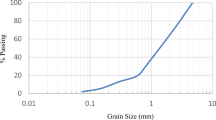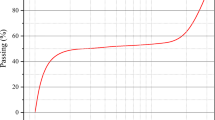Abstract
Environmental protection around radioactive waste disposal is a very important issue for safety purposes. Consequently, permeability and radiation shielding are the two important factors for isolating radioactive disposals. Clay is relatively impermeable soil that is naturally available, cheap and environmentally friendly. In this research, the influence of modifying clay by barite powder was investigated to improve the gamma ray shielding performance while keeping the low permeability of clay soil. This research was conducted using both experimental and simulation methods. In this study, bentonite clay samples with 10%, 20%, 30%, 40%, 60% and 80% of barite powder was prepared to find the optimum percent of barite powder. A HPGe detector was used to measure the attenuation coefficients at commonly used gamma ray energies of 137Cs (661.6 keV) and 60Co (1173.2 and 1332.5 keV) for all the samples. The attenuation coefficients for samples were determined by both simulation method, using the MCNP code, and XCOM database to compare with the experimental results. Simulation results were found to be in good agreements with the experimental results. The obtained results show that with increasing the percent of barite powder, radiation shielding coefficient (µ) increase while permeability coefficient becomes grater. However, according to the obtained results, the bentonite clay with 40% of barite powder is the optimum composition with a permeability factor of 8.87 × 10−11 m/s and attenuation coefficient of 16.46 m−1, 12.2 m−1 and 11.99 m−1 at 661.6, 1173.2 and 1332.5 keV energies, respectively. In addition, the results for clayey soil samples were compared to the concrete mixture. It was found that clay mixture with 40% barite powder would overcome concrete regarding gamma-ray shielding performance. As a result, the clay composite particularly due to its imperviousness and availability, seems to be an appropriate alternative for radiation shielding in radioactive waste disposal landfills.








Similar content being viewed by others
Notes
High Pure Germanium Detector (HPGe).
References
Akbulut S, Sehhatigdiri A, Eroglu H, Çelik S (2015) A research on the radiation shielding effects of clay, silica fume and cement samples. Radiat Phys Chem 117:88–92
Akkurt I, El-Khayatt A (2013) The effect of barite proportion on neutron and gamma-ray shielding. Ann Nucl Energy 51:5–9
Akkurt I, Akyildirim H, Mavi B, Kilincarslan S, Basyigit C (2010) Gamma-ray shielding properties of concrete including barite at different energies. Prog Nucl Energy 52(7):620–623
Awadallah MI, Imran MM (2007) Experimental investigation of γ-ray attenuation in Jordanian building materials using HPGe-spectrometer. J Environ Radioact 94(3):129–136
Bergaya F, Lagaly G (2006) General introduction: clays, clay minerals, and clay science. Dev Clay Sci 1:1–18
Briesmeister JF (1986) MCNP: a general Monte Carlo code for neutron and photon transport. Version 3A. Revision 2 (No. LA--7396-M-REV. 2). Los Alamos National Laboratory, Los Alamos
Cedergren HR (1997) Seepage, drainage, and flow nets, vol 16. Wiley, New York, pp 24–35
Cember H (1969) Introduction to health physics. Pergamon Press, Oxford, pp 179–181
Chilton AB, Shultis JK, Faw RE (1984) Principles of radiation shielding, 1st edn. Prentic-Halle, Englewood Cliffs
Cohen BL (2011) The cancer risk from low level radiation. In: Radiation dose from multidetector CT. Springer, Berlin, pp 61–79
Erdem M, Baykara O, Doğru M, Kuluöztürk F (2010) A novel shielding material prepared from solid waste containing lead for gamma ray. Radiat Phys Chem 79(9):917–922
Gillies M, Richardson DB, Cardis E, Daniels RD, O’Hagan JA, Haylock R, Schubauer-Berigan MK (2017) Mortality from circulatory diseases and other non-cancer outcomes among nuclear workers in France, the United Kingdom and the United States (INWORKS). Radiat Res 188(3):276–290
Jaeger RG (1975) Engineering compendium on radiation shielding. Volume II. Shielding materials, Chap 9, pp 31–33
Kharita M, Yousef S, AlNassar M (2011) Review on the addition of boron compounds to radiation shielding concrete. Prog Nucl Energy 53(2):207–211
Kucuk N, Tumsavas Z, Cakir M (2012) Determining photon energy absorption parameters for different soil samples. J Radiat Res 54(3):578–586
Landais P, Aranyossy JF (2004) Clays in natural and engineered barriers for radioactive waste confinement. Appl Clay Sci 26(1–4):1
Mann HS, Brar GS, Mann KS, Mudahar GS (2016) Experimental Investigation of clay fly ash bricks for gamma-ray shielding. Nucl Eng Technol 48(5):1230–1236
Martin JE (2006) Physics for radiation protection: a handbook. Wiley, New York, pp 30–37
Medhat M (2009) Gamma-ray attenuation coefficients of some building materials available in Egypt. Ann Nucl Energy 36(6):849–852
National Research Council (2006) Health risks from exposure to low levels of ionizing radiation: BEIR VII phase 2, vol 7. National Academies Press, Washington, pp 43–89
NIST XCOM (nd) Element/compound/mixture—physical measurement. National Institude of Standard and Technology. Retrieved from: https://physics.nist.gov/PhysRefData/Xcom/Text/ref.html. Accessed July 2017
Rezaei-Ochbelagh D, Azimkhani S (2012) Investigation of gamma-ray shielding properties of concrete containing different percentages of lead. Appl Radiat Isot 70(10):2282–2286
Ryan M (1998) Planning and operation of low level waste disposal facilities. Health Phys 74:119
Shams T (2016) Investigation of gamma ray attenuation in multi layered and mixture heavyweight concrete shields containing hematite and barite aggregate. Dissertation, Isfahan University of Technology, Esfahan, Iran
Sharifi S, Bagheri R, Shirmardi SP (2013) Comparison of shielding properties for ordinary, barite, serpentine and steel–magnetite concretes using MCNP-4C code and available experimental results. Ann Nucl Energy 53:529–534
Shultis JK, Faw RE, Kase KR (1996) Radiation shielding. Prentice Hall PTR, Upper Saddle River, New Jersey
Singh VP, Badiger N (2015) Gamma-ray and neutron shielding properties of some soil samples. Indian J Pure Appl Phys (IJPAP) 52(9):579–587
Singh N, Singh KJ, Singh K, Singh H (2004) Comparative study of lead borate and bismuth lead borate glass systems as gamma-radiation shielding materials. Nucl Instrum Methods Phys Res Sect B 225(3):305–309
Team MC (2003) MCNP—A general Monte Carlo N-particle transport code, version 5. Book MCNP-A General Monte Carlo N-Particle Transport Code Version, 5
US Nuclear Regulatory Commission (1993) Standards for protection against radiation. US Government Printing Office, Washington, 10, 20-1001
Wood J (2013) Computational methods in reactor shielding. Elsevier, New York, pp 79–118
Author information
Authors and Affiliations
Corresponding author
Rights and permissions
About this article
Cite this article
Share Isfahani, H., Abtahi, S.M., Roshanzamir, M.A. et al. Permeability and Gamma-Ray Shielding Efficiency of Clay Modified by Barite Powder. Geotech Geol Eng 37, 845–855 (2019). https://doi.org/10.1007/s10706-018-0654-0
Received:
Accepted:
Published:
Issue Date:
DOI: https://doi.org/10.1007/s10706-018-0654-0




